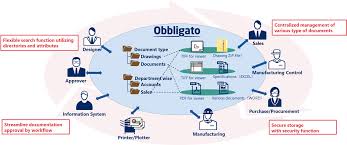
The Importance of a Drawing Management System in Modern Businesses
In today’s fast-paced business environment, the efficient management of drawings and technical documents is crucial for ensuring smooth operations and project success. A drawing management system plays a vital role in organizing, storing, and retrieving critical design files, blueprints, and engineering drawings.
One of the key benefits of a drawing management system is centralizing all design-related documents in one secure location. This eliminates the need for multiple versions scattered across different departments or individuals, reducing the risk of errors and ensuring that everyone works from the most up-to-date version.
Furthermore, a drawing management system enhances collaboration among team members by providing easy access to drawings from anywhere at any time. Whether working on-site or remotely, employees can retrieve necessary drawings quickly and efficiently, streamlining communication and decision-making processes.
Version control is another significant advantage offered by drawing management systems. By tracking changes and revisions to drawings, businesses can maintain a clear audit trail of who made what modifications and when. This not only ensures accountability but also minimizes the likelihood of errors resulting from working on outdated versions.
Security is paramount when it comes to sensitive design files and intellectual property. A robust drawing management system provides access controls and permissions to safeguard confidential information, preventing unauthorized users from viewing or editing critical drawings.
As businesses expand globally and collaborate with partners across different time zones, having a centralized drawing management system becomes essential for maintaining consistency and standardization in design practices. It promotes efficiency by eliminating duplication of efforts and ensuring that all stakeholders are aligned with the latest design specifications.
In conclusion, investing in a drawing management system is not just about organizing files—it’s about optimizing workflows, enhancing collaboration, improving security measures, and ultimately driving business success. By leveraging technology to streamline drawing management processes, modern businesses can stay ahead of the competition and deliver high-quality projects efficiently.
Five Essential Strategies for Effective Drawing Management Systems
- Organize drawings in a clear and logical folder structure.
- Use version control to track changes and revisions.
- Include detailed metadata for each drawing, such as project name, date, and author.
- Implement access control to ensure only authorized users can view or edit drawings.
- Regularly back up all drawings to prevent data loss.
Organize drawings in a clear and logical folder structure.
To effectively manage drawings in a drawing management system, it is essential to organize them in a clear and logical folder structure. By structuring drawings systematically, users can easily navigate through files, locate specific drawings efficiently, and maintain consistency across projects. A well-organized folder structure not only improves accessibility but also enhances collaboration among team members by ensuring that everyone can quickly find the information they need. Additionally, a logical folder arrangement facilitates version control and helps prevent duplication of files, ultimately leading to smoother workflows and increased productivity in design processes.
Use version control to track changes and revisions.
Utilizing version control in a drawing management system is a critical practice to monitor and manage changes and revisions effectively. By implementing version control, businesses can maintain a clear record of all modifications made to drawings, ensuring transparency and accountability within the design process. This feature allows teams to track the evolution of a drawing, identify who made specific changes, and revert to previous versions if needed. With version control, organizations can streamline collaboration, minimize errors resulting from working on outdated drawings, and uphold consistency in design practices across projects.
Include detailed metadata for each drawing, such as project name, date, and author.
When implementing a drawing management system, it is essential to include detailed metadata for each drawing, such as the project name, date, and author. This information not only provides crucial context for understanding the purpose and history of the drawing but also facilitates efficient search and retrieval processes. By organizing drawings with comprehensive metadata, businesses can enhance traceability, ensure accountability, and streamline collaboration among team members working on various projects.
Implement access control to ensure only authorized users can view or edit drawings.
Implementing access control is a critical aspect of a drawing management system to ensure that only authorized users have the ability to view or edit drawings. By setting up proper permissions and restrictions, businesses can safeguard sensitive design files and intellectual property from unauthorized access. This security measure not only protects confidential information but also helps maintain data integrity and prevent potential breaches or misuse of critical drawings. Effective access control mechanisms are essential for maintaining a secure and compliant environment within the organization’s drawing management system.
Regularly back up all drawings to prevent data loss.
Regularly backing up all drawings is a crucial tip in drawing management systems to prevent data loss. By creating frequent backups of design files, businesses can safeguard against unforeseen events such as system failures, accidental deletions, or data corruption. This proactive measure ensures that valuable drawings are always secure and accessible, providing peace of mind and continuity in project workflows. Emphasizing the importance of regular backups helps maintain the integrity of design data and minimizes the impact of potential disruptions on business operations.
